Design by, with, and for Neurodivergent Learners: Part 7 — Word Cards
By Teon Edwards
Can you make sense of the following?
Instructional content ought to be curated with multimodal delivery—incorporating orthographic scaffolds, sonorous supplements, and lexically attenuated prose—to accommodate heterogeneous cognitive architectures. Employing hierarchical structuration, typographic uniformity, and minimization of extraneous perceptual stimuli can enhance epistemic accessibility for neurodivergent constituencies.
What is wrong with it?
It was written by ChatGPT, with the prompt to rewrite the paragraph below using “big words and obscure terms”.
Educational materials should be designed with multiple formats—such as visual aids, audio options, and simplified text—to support diverse learning styles. Clear structure, consistent layouts, and reduced sensory distractions can help neurodivergent learners better engage with and retain information.
Obviously, the best way to make written material accessible is simply to NOT use “big words and obscure terms”! However, sometimes there are reasons to use specialized terms.
As part of INFACT—Including Neurodiversity in Foundational and Applied Computational Thinking (DOE; EIR-U411C190179)—we created a comprehensive and inclusive set of materials for computational thinking in grades 3–8. “Computational thinking” is, itself, a specialized term:
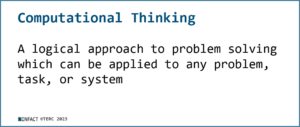
And computational thinking involves other specialized terms, such as:
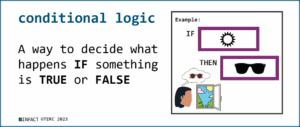
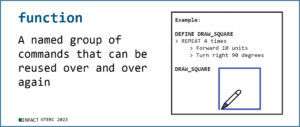
The INFACT materials don’t require students to memorize these terms, but they are used. So the materials include word cards to serve as scaffolds—a specialized term I use all the time.
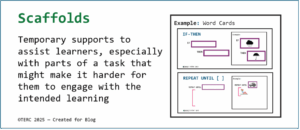
We recommend educators use the word cards when introducing or discussing terms. We also recommend educators give them to learners and encourage learners to ask for or access them whenever having the cards might be helpful.
Ensure obfuscatory terminology does not compromise discernment!
Coming soon in the Designing by, with, and for Neurodivergent Learners series:
Part 8 — Anatomy of Activities
Can you make sense of the following?
Instructional content ought to be curated with multimodal delivery—incorporating orthographic scaffolds, sonorous supplements, and lexically attenuated prose—to accommodate heterogeneous cognitive architectures. Employing hierarchical structuration, typographic uniformity, and minimization of extraneous perceptual stimuli can enhance epistemic accessibility for neurodivergent constituencies.
What is wrong with it?
It was written by ChatGPT, with the prompt to rewrite the paragraph below using “big words and obscure terms”.
Educational materials should be designed with multiple formats—such as visual aids, audio options, and simplified text—to support diverse learning styles. Clear structure, consistent layouts, and reduced sensory distractions can help neurodivergent learners better engage with and retain information.
Obviously, the best way to make written material accessible is simply to NOT use “big words and obscure terms”! However, sometimes there are reasons to use specialized terms.
As part of INFACT—Including Neurodiversity in Foundational and Applied Computational Thinking (DOE; EIR-U411C190179)—we created a comprehensive and inclusive set of materials for computational thinking in grades 3–8. “Computational thinking” is, itself, a specialized term:

And computational thinking involves other specialized terms, such as:


The INFACT materials don’t require students to memorize these terms, but they are used. So the materials include word cards to serve as scaffolds—a specialized term I use all the time.

We recommend educators use the word cards when introducing or discussing terms. We also recommend educators give them to learners and encourage learners to ask for or access them whenever having the cards might be helpful.
Ensure obfuscatory terminology does not compromise discernment!
Coming soon in the Designing by, with, and for Neurodivergent Learners series:
Part 8 — Anatomy of Activities
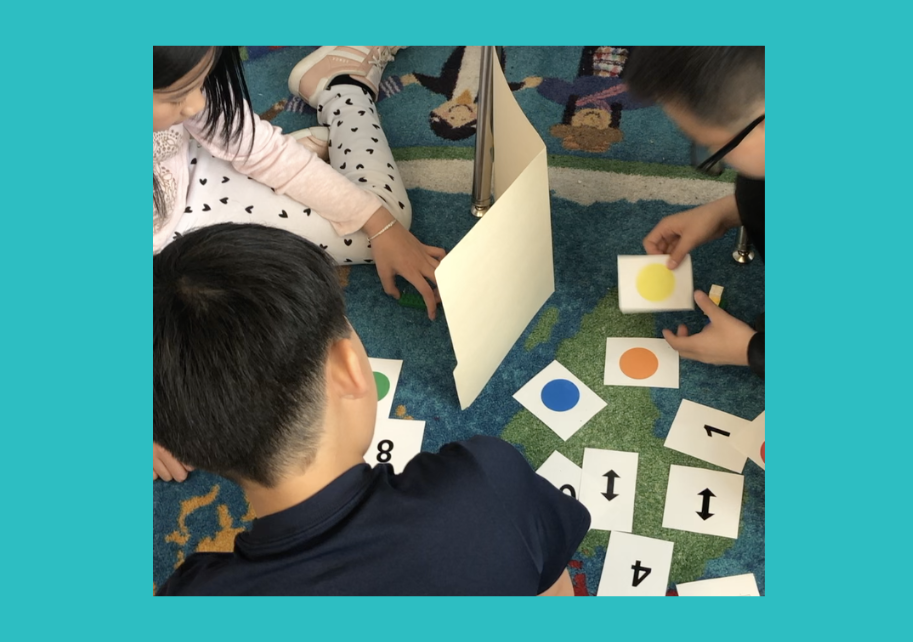
9/29/2025
AuthorTeon Edwards is the director and a co-founder of EdGE at TERC. Her current work focuses on the use of virtual reality and other technologies to design and develop inclusive STEM learning experiences, with a particular focus on neurodiversity and sensory, attention, and social differences.
SummaryTeon Edwards, PI of Broadening Participation in Informal STEM Learning for Autistic Learners and Others through Virtual Reality, considers the use of specialized terms in STEM learning.
More Posts in this Series- Part 1 — Introduction
- Part 2 — Computational Thinking Posters
- Part 3 — Zoombinis Allergic Cliffs Flashlight Scaffold
- Part 4 — Zoombinis Allergic Cliffs Expression Scaffold
- Part 5 — Brightness Controls
- Part 6 — Red Alert
Share This Page:
